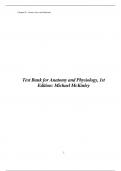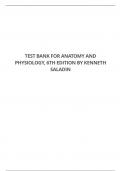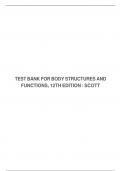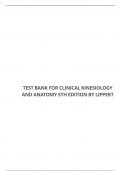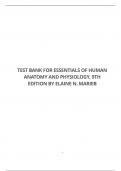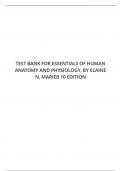Duke University School Of Medicine
Latest uploads at Duke University School Of Medicine. Looking for notes at Duke University School Of Medicine? We have lots of notes, study guides and study notes available for your school.
-
496
- 0
-
6
All courses for Duke University School Of Medicine
- Assessment of Visual and Auditory Systems Lewis: Medical-Surgical Nursing, 10th Edition 1
- ATI Maternal Newborn & Peds 1
- ATI Maternal Newborn Practice B 1
- ATI Maternal Newborn Proctored Exam 2020 / 2021 1
- ATI Maternal Newborn- Practice 2019 B 1
- ATI Med-Surg part A 1
- ATI PHARMACOLOGY ASSESSMENT 2019 1
- ATI PN MENTAL HEALTH PROCTORED EXAM 1
- ATI Skills module 2.0 Medication Administration 1 Notes 1
- Medical-surgical nursing ,10th Edition : assessment and management of clinical problems 5
- Medical-surgical nursing, 10th Edition : assessment and management of clinical problems 3
- MKT 331 Chapters 1 and 2 Test with answers - Cornell University 1
- MN 566 Week 5 Quiz {2020} - Cornell University 1
- MN 566 Week 7 Quiz {2020} - Cornell University 1
- MN 576 Unit 5 Midterm Exam: Cornell University 1
- MN566 Midterm Quiz {2020} – Cornell University 1
Latest notes & summaries Duke University School Of Medicine
Chapter 02 - Atoms, Ions, and Molecules Chapter 02 Atoms, Ions, and Molecules Fill in the Blank Questions 1. Anything that has mass and occupies space is considered to be ________. matter Bloom's Level: 1. Remember HAPS Objective: C01.01a With respect to the structure of an atom: Describe the charge, mass, and relative location of electrons, protons and neutrons. HAPS Topic: Module C01 Atoms & molecules. Learning Objective: 02.01.01 Define matter, and list its three forms. Section: 0...
Exam Name___________________________________ MULTIPLE CHOICE. Choose the one alternative that best completes the statement or answers the question. 1) ________ is considered the oldest medical science. 1) A) Physiology B) Biology C) Cytology D) Embryology E) Anatomy 2) Anatomy is to ________ as physiology is to ________. 2) A) structure; form B) structure; function C) growth; form D) function; form E) form; structure 3) The analysis of the internal structure of individual cells is...
1 Student: 1. The term used to describe something pertaining to the internal organs is A. visceral. B. proximal. C. peripheral. D. deep. 2. The term peripheral refers to a structure that is A. toward the abdominal surface. B. away from the body surface. C. away from the center of the body. D. to the left of the midline. 3. The chin is to the mouth, and the knee is to the ankle. A. anterior; distal B. inferior; distal C. superior; proximal D. inferior; proximal 4. The integumenta...
chapter 01 True / False Questions 1. Feeling for swollen lymph nodes is an example of auscultation. True False 2. We can see through bones with magnetic resonance imaging (MRI). True False 3. Histology is the study of structures that can be observed without a magnifying lens. True False 4. Cells were first named by microscopist Robert Hooke. True False 5. All functions of the body can be interpreted as the effects of cellular activity. True False 6. The hypothetico-deductive met...
Chapter 1: The Major Issues TRUE/FALSE 1. Neuroscientists are more interested in studying behavior than biological psychologists. ANS: F PTS: 1 DIF: factual REF: Introduction OBJ: 1 TOP: 1.1 The Biological Approach to Behavior 2. According to Tinbergen, a physiological explanation describes why a structure or behavior evolved as it did. ANS: F PTS: 1 DIF: factual REF: Introduction OBJ: 1 TOP: 1.1 The Biological Approach to Behavior 3. An evolutionary explanation describes why a structur...
CHAPTER 1 BIOPSYCHOLOGY AS A NEUROSCIENCE: WHAT IS BIOPSYCHOLOGY, ANYWAY? MULTIPLE CHOICE QUESTIONS 1) The human brain weighs about A) 0.3 kilograms (0.7 pounds). B) 0.8 kilograms (1.8 pounds). C) 1.0 kilograms (2.2 pounds). D) 1.3 kilograms (2.9 pounds). E) 2.3 kilograms (5.1 pounds). Answer: D Diff: 2 Page Ref: 2 Topic: Chapter 1 Introduction 2) The human brain is composed of various cells, including about 100 billion that are specialized to receive and transmit electrochemical si...
1 Chapter 1: Introduction to the Structural Units TRUE/FALSE 1. The pelvic cavity contains the organs of the reproductive and excretory system. ANS: T PTS: 1 2. The thoracic cavity protects the heart and lungs. ANS: T PTS: 1 3. The lungs are located inferior to the diaphragm. ANS: F Inferior refers to below and the lungs are above, or superior, to the diaphragm. PTS: 1 4. The kidneys are located within the abdominal cavity. ANS: F The kidneys are located behind the abdominal cavity;...
Chapter 1: Basic Information Multiple Choice Identify the choice that best completes the statement or answers the question. ____ 1. The fibula is on which side of the lower leg? a. Medial c. Proximal b. Lateral d. Distal ____ 2. The ulna is where in relation to the humerus? a. Medial c. Proximal b. Lateral d. Distal ____ 3. In anatomical position, the thumb is located where in relation to the fingers? a. Medial c. Proximal b. Lateral d. Distal ____ 4. In moving from anatomical positi...
Essentials of Anatomy and Physiology, 9e (Marieb) Chapter 1 The Human Body: An Orientation Short Answer Figure 1.1 Using Figure 1.1, identify the following: 1) Label A points to the __________ cavity. Answer: cranial Diff: 1 Page Ref: 20 2) Label B points to the __________ cavity. Answer: spinal Diff: 1 Page Ref: 20 3) Label C points to the __________ cavity. Answer: thoracic Diff: 1 Page Ref: 20 4) Label D points to the __________. Answer: diaphragm Diff: 1 Page Ref: 20 5) Labe...
Figure 2.1 Using Figure 2.1, match the following: 1) Lipid. Answer: D 2) Functional protein. Answer: B 3) Nucleotide. Answer: E 4) Polysaccharide. Answer: C 5) Monosaccharide. Answer: A 6) Polymer. Answer: C 7) Tertiary (protein) structure. Answer: B

